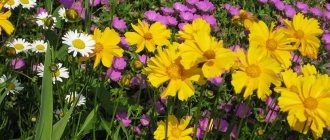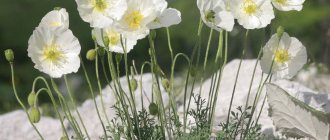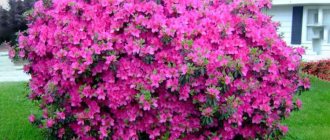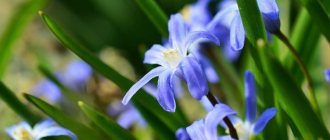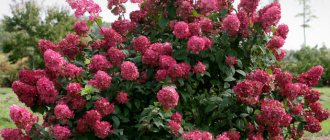Poppy is a beautiful, bright plant with surprisingly expressive flowers. Bright, richly colored petals attract everyone's attention and leave no one indifferent. Many famous artists chose this plant as a subject for their paintings. Oriental poppy can be found not only in paintings, but also everywhere - on furniture, dishes and clothes. Among all the varieties of poppy, the Oriental poppy is one of the most famous, the most beautiful and the most popular.
Botanical description of the plant, main characteristics
The growing area of the oriental perennial poppy is the Caucasus, Türkiye and Iran.
The description is as follows:
- The bush is spreading, reaching a height of about 90 cm.
- The stem is a peduncle, erect, less often curved, covered with white fibers at the bottom.
- The root system is powerful, going deep into the ground.
- The leaves are lanceolate, oblong, the edges are pinnately dissected, the color is green, with white fluff.
- Opened buds are 10-20 cm in diameter, the number of petals is 4-6 pieces.
- Color - represented in all shades of red, pink and orange. Some varieties have a dark spot at the base of the flower.
- Stamens are purple or black, elongated.
- The fruits are small grains of brown color and oblong shape.
The flowering of garden perennial poppy lasts from the beginning of June until the second half of July.
Description
According to descriptions, Oriental poppy is a perennial, herbaceous plant that belongs to the Poppy family.
It is often called the Eastern papaver poppy, the fact is that poppy in Latin is papaver. Its maximum size can be quite high, averaging 85-95 centimeters.
The leaves have a pale green tint, are large in size, and covered with hard down. The cup-shaped flowers are very large, approximately 18-22 centimeters. Their color is very bright from dark orange to rich red.
General information
Flowering lasts about a month. It most often begins in the second ten days of May and ends in mid-June. In their natural environment, poppies grow on low slopes, near forests. This plant is quite light-loving, but a small shade does not cause damage.
Grows best in light soil containing sand. Excessive soil moisture can be destructive; with excessive watering, the roots can begin to rot.
The legislation of the Russian Federation prohibits the cultivation of oriental poppy throughout the country. You should familiarize yourself with some documents that describe in detail the handling of this plant.
Types and varieties
Chinese poppy, as it is also called, includes more than 200 varieties that differ in different colors. In dachas and flower beds, flower growers most often cultivate the most popular varieties:
- Mrs Perry;
- May Queen;
- Indian chief;
- Perry's White.
Almost all varieties of oriental poppy are hybrid. Depending on the variety, the petals of the plant can be colored red, pink, purple, white, or lilac.
All oriental varieties are characterized by a large diameter of flowers
Diseases and pests: treatment methods
Insect pests rarely attack the plant, mainly only aphids. However, poppies are often affected by various diseases. If simple care rules are not followed, oriental poppies can get sick:
- black spot fungus;
- powdery mildew;
- root rot.
If diseased parts of the bush are found, they should be immediately cut out and destroyed by burning. To prevent further spread of the disease, the plant is treated with a mixture of Bordeaux, copper sulfate, and Maxim and Topaz fungicides.
Features of planting and agricultural technology
Planting and caring for perennial poppies in open ground will not cause any particular difficulties for the gardener. The plant is quite unpretentious and frost-resistant.
The perennial oriental poppy prefers hills where water does not accumulate. The site must be protected from winds and drafts. Lighting is plentiful.
Landing
Step-by-step algorithm for planting poppy seeds:
- Planting time is spring, when the soil warms up by at least +5 °C.
- The seed material is slightly buried in the soil or simply scattered on top of it.
- The beds are covered with polyethylene to create a greenhouse.
- Watering is carried out as the top layer of soil dries.
- The time for the first shoots to appear is from 10 to 14 days. When seedlings appear, the film must be removed.
Given the unstable spring weather, seedlings must be covered with film when night frosts return.
Autumn sowing of poppy before winter is possible. It is held in November, when the temperature is no higher than +3 °C. At higher temperatures, there is a risk of premature germination of seedlings, which will die during the first cold snap.
Autumn planting is preferable as the grains undergo a natural stratification process. Autumn poppies begin to bloom earlier.
Hardening makes plants more resilient
Poppy bushes grow straggling; this must be taken into account when planting, keeping the distance between grains at least 50 cm. Otherwise, the seedlings will have to be thinned out.
Preparatory work before planting
Before planting, it is necessary to carry out a number of preparatory work:
- The selected area is cleared of weeds and dug up with the addition of humus, compost or other organic matter.
- If planting will be carried out in the spring, it is recommended to stratify the seed material by placing it in the refrigerator for 1 - 1.5 months.
An additional measure is to treat the seeds with a growth stimulant and soak them for 20 minutes in a solution of potassium permanganate for disinfection.
Poppy does not tolerate transplants well. It can grow in one place for 5 to 7 years without losing the vigor of its flowering, so the choice of location must be taken seriously.
If the plant is planned to be planted in a lowland, drainage must be organized to prevent water stagnation.
Why doesn't the oriental poppy bloom?
There may be several reasons why a plant does not produce bright flowers:
- The plant is too young. The first few years of growing oriental poppy from seed are devoted to the formation of the root system. In the second or third year, the plant may produce 1-2 flower stems. Only in this case can you expect full, lush and bright flowering of the bush.
- Inappropriate place for a flower. Growing in a very shady location can significantly affect the formation of flower buds.
- Mistakes in caring for flowers. Although the oriental poppy is considered a rather unpretentious flower, lack of attention and lack of proper care can lead to a lack of buds. Too deep and active scarification can damage the root system. The plant directs all its energy to repair and heal the wound.
- Transfer. “Moving” from one place to another is very difficult for a plant. In most cases, the next year after replanting, the bush may be left without flowers.
You should know that according to current legislation, the cultivation of oriental poppy in Russia is prohibited. And all because of the presence of narcotic and hallucinogenic, toxic substances in its composition. Thus, the oriental poppy contains oripavine, which is included in the official list of narcotic drugs.
If you are in doubt whether a plant is prohibited or not, pay attention to the seed pod; if it is large, then most likely this type of poppy is prohibited and should not be grown.
If you grow small quantities of oriental poppies, no more than 6-9 bushels, you may be subject to a civil fine. A fine can be imposed even for one bush. Criminal liability applies only for the cultivation of “drug-containing” plants on a large or especially large scale. To do this, the oriental poppy must have at least 10 plants in the area, regardless of their size.
Oriental flower care
If we talk about this decorative, perennial poppy, planting and caring for it will not be difficult. It will delight you with abundant and long-lasting flowering, provided that simple agrotechnical measures are followed.
When caring for poppy seeds, do not forget about applying fertilizers. Although the bush can develop and bloom normally without fertilizing, it is recommended to apply mineral supplements at intervals of 2-4 weeks throughout the season.
The plant responds to fertilizers by forming lush foliage and longer flowering.
The main aspects of care are watering, fertilizing, timely replanting
Watering
Soil moisture should be regular but moderate. The plant does not like excessive moisture.
It is necessary to focus on the condition of the soil - watering is carried out as its top layer dries out.
Temperature
Oriental poppy is a heat-loving plant, but it is not afraid of winter frosts down to -35 ° C, which it can tolerate even without additional insulation.
Sheltering bushes in extreme cold is necessary if the winter season turns out to be snowless.
Mulch can be used as insulation
Garter bushes
Oriental poppy bushes are quite tall; they can break off under the influence of winds or under the weight of large buds.
Wooden pegs are used as support, which are placed near the bushes. The plant is tied to the supports with a rope.
Transfer
Poppy transplantation is carried out every 5-7 years. The plant must be carefully dug up without damaging the deep root system and without destroying the earthen ball around it. Together with a lump of old soil, the bush is transferred to a new place.
The time for transplantation is autumn, when the poppy has faded.
Properties of poppy seeds - harm and benefit
Beneficial features
The properties of the opium poppy were discovered in ancient times: a drink made from its seeds was used as an analgesic and sleeping pill. Poppy was popular in Ancient Greece: myths say that the seeds of this plant were carried with them by the deity of sleep Hypnos and the god of dreams Morpheus, as well as the goddess of fertility Hera. In Europe, during the reign of Charlemagne, poppy was so highly valued that peasants had to hand over 26 liters of poppy seeds to the state. Poppy was used to treat the sick, and it was given to children to help them sleep better. And no one suspected that poppy was not so safe until, in the 16th century, the physician and botanist Jacob Theodorus published the book “Poppy Seed Juice,” in which he described not only the beneficial properties of poppy, but also the harm that it can cause. cause.
The composition of poppy seeds includes fat, sugars and proteins, vitamins E, PP, elements cobalt, copper, zinc, phosphorus, iron and sulfur, and the petals contain fatty oil, vitamin C, alkaloids, glycosides, anthocyanins, flavonoids, organic acids and gum . Poppy oil is one of the most valuable vegetable oils. It is used to make paints and cosmetics.
Blue poppy seeds are used as an expectorant; poppy decoction relieves toothache and ear pain. Preparations made from poppy seeds are prescribed for liver diseases, insomnia, stomach catarrh, pneumonia, and hemorrhoids. A decoction of poppy roots treats inflammation of the sciatic nerve and migraines; a decoction of poppy seeds improves digestion. Poppy helps reduce sweating, cope with diarrhea and dysentery, and relieve bladder inflammation. The pharmacological industry produces such potent drugs from poppy as codeine, morphine, papaverine, narcein, narcotine, but before you start using these drugs, you should definitely consult your doctor.
- Deytsia: cultivation, types and varieties
Contraindications
Some people should absolutely not use poppy-based medications. The risk group includes the elderly, children under two years of age, people prone to alcohol abuse, as well as those who suffer from cholelithiasis, anoxemia, pulmonary emphysema, bronchial asthma, depressed breathing or chronic constipation.
Reproduction methods
Poppy is propagated by cuttings, seeds and division.
You can collect the seeds yourself when the seed pods are ripe and plant them immediately in open ground, or prepare seedlings in greenhouse conditions.
But since poppy does not tolerate transplantation well, the seedling method is practically not used.
Division method:
- Bushes that are at least 3 years old are suitable for division. The time for the procedure is spring, before the buds begin to form, or autumn, after the plant has flowered.
- Part of the root system is separated from the side of the mother bush.
- The delenka is carefully examined, damaged or diseased roots are removed.
- The rhizome is planted in the prepared hole.
The first flowering after propagation by division occurs in the next season.
Cuttings:
- shoots at least 10 cm long are cut from the mother bush;
- the cuttings are soaked in a growth stimulator for a day;
- planting is carried out in nutritious, loose soil, pre-moistened.
The top of the cutting must be covered with film or a plastic bottle.
As soon as the cutting takes root, which will be evident from its increased growth, it can be replanted to a permanent place.
How to propagate oriental perennial poppy
Oriental poppy can be propagated in various ways - by dividing the bush, cuttings and seeds.
The seed method is the most accessible and simplest, which is why it is most often used for poppy propagation.
Seeds are sown in early spring or late autumn. To get a healthy, vigorous plant, poppy seeds need to be stratified. To do this, they should be sown in the soil when the likelihood of frost is high. In autumn, poppy is sown in November, when the soil is cooled and the temperature does not rise above 3-5 degrees, otherwise the poppy may germinate and the seedlings will die at the beginning of winter. Because cold soil and low temperatures are not an obstacle to seed germination. For spring sowing, sow seeds as soon as the snow melts.
Flowering of sown plants should be expected no earlier than after 2-3 years.
All vegetative methods require preliminary rooting and are more labor-intensive. Oriental poppies do not always take root in a new location, and it takes at least 2-3 years for the plant to bloom.
A large, spreading shrub can be divided at the age of 3-5 years and propagated in this way.
With this method, you do not need to dig up the entire bush, but carefully remove part of the rhizome from the side. In various gardening literature it is recommended to divide the shrub in the spring before flowering or in the fall after it. In any case, the rhizome should be divided, preserving a large lump of native soil, since the roots are quite fragile and can be easily damaged.
After digging up the plant, it should be divided. When transplanting an adult plant to a new location, it is recommended to divide the poppy bush. A large bush is carefully divided into parts using a knife. The pieces are planted at a distance of 50-70 cm from each other.
This method of propagation by dividing the bush results in a plant identical to the mother, with a 100% guarantee of maintaining the varietal characteristics of the species.
However, young areas are very sensitive and may die due to bad weather. With the onset of cold weather, in the first year of life, these plants should be covered.
Propagation by green shoots or cuttings
Separate the side shoots from the bush; you can choose any, but gardeners recommend using weaker ones for this method. To root cuttings and better develop the root system, soak the shoots in rhizome or another root growth stimulator for the next 24 hours. Then the cuttings are planted in fertile, loose, moist soil and covered with a transparent lid. After roots have formed, transplant the cuttings to a permanent place in the garden.
Features of cultivation
For good growth and beautiful flowering, poppy does not need to create conditions of increased comfort; it is an unpretentious plant.
- Oriental poppy will like sandy, loose soil without stagnant water. On poor lands with high acidity, flowers become smaller.
- The most suitable place would be an open and sunny area, but with a little shading the flower also grows well. In shady places, flower buds set worse, and in some cases flowering does not occur at all.
- Oriental poppy is a fairly drought-resistant perennial. Its long tap root allows it to find moisture deep in the ground. It can grow without watering, but regular moistening ensures more luxuriant flowering. Many varietal plants do not tolerate periodic drought well. Stagnation of water can lead to rotting of the roots.
- Before planting, the soil is fertilized with humus (5-10 kg per square meter of land) and mineral fertilizer (30-50 g per square meter). Then they dig to a depth of 30-40 cm. Subsequently, nutrients are added 1-2 times per season.
- Regular loosening will help provide the poppy with air flow to the roots. At the same time, weeds are removed from the area, and then the soil is mulched with peat or other materials.
- Large perennial poppies need support during bud formation. The tall stem is tied to it with fairly wide ropes. Thin nylon threads are not used - they damage the stems.
- After flowering, dying foliage and stems are cut off at ground level. By autumn, smaller leaves will grow. If you need to collect seeds, the procedure is carried out after the fruit-pods have ripened.
- Poppy can withstand frosts down to -40 degrees. Mature bushes do not require additional shelter for the winter, but it is better to take care of protection from frost for rare and varietal species. They are covered with dry leaves.
If you do not plan to collect poppy heads for seeds, they are cut off after flowering. This prolongs the flowering period of plants, because the flower spends a lot of energy on the ripening of fruit boxes.
Place Pigalle (Papaver Or. Place Pigalle)
This red oriental poppy is a worthy competitor to the above-mentioned favorite of gardeners. It is in no way inferior to it in the beauty and brightness of its delicate petals. The high position in the table of ranks is evidenced by the luxurious black crown of stamens in the center of the corolla. As a noble representative of the family, Place Pigalle requires special treatment. It grows well in sunny areas, reliably protected from the wind, and only on fertile soils.
LiveInternetLiveInternet
–Search by diary
– Quote book
Walk through the gardens – “Flower jam. “The day will come when you will open your eyes and see: the garden is standing.
The pink country of VDNKh The faded rose breathed sadly, Admiring the sun at the crimson sunset, It moved.
Siamese tulip Siamese tulip. aka Turmeric - it turns out that it’s also a relative of ginger, really.
Gardens for “Flower Jam” The wind plays through the leaves in the branches, The garden greets the dawn with the singing of birds, S.
City flowers. In cities where the dawn is not visible in winter, Where the distance is hidden behind the roofs, In spring.
–Categories
- Sowing and propagation. (291)
- Seeds and seedlings. (149)
- Layering, cuttings, division. (62)
- Fertilizers, fertilizers, compost. (157)
- Master classes, schemes, plans (153)
- Water. (53)
- My flowers. (748)
- Indoor flowers. (455)
- Orchids. (37)
- One- and two-year-old flowers. (174)
- Petunia. (35)
- Perennials. (735)
- Clematis. (52)
- Lilies. (42)
- Weeds. (40)
- Peonies. (35)
- Plodovo-Ogorodnoye. (802)
- Vegetables, herbs. (481)
- Fruits, berries and fruits. (207)
- Trees, bushes. (405)
- Conifers (43)
- Rockeries, other flower beds. (120)
- ROSES. (190)
- Diseases and pests. (219)
- Flower compositions. (162)
- DESIGN. (444)
- DECO ideas. (454)
- Useful TIPS, links. (1008)
- Questions for gardeners. (270)
- Gardens of the world. (182)
- Recipes and herbal medicine. (183)
- Conversations, meetings, exchange. (119)
- Exchange and sale of flowers. (1)
- A little lyricism and romance. (223)
- Download magazines, books, programs. (143)
–Tags
–Links
-Music
–Photo album
– Regular readers
–Broadcasts
-Statistics
How to collect seeds?
The poppy boxes are carefully cut off after they are completely dry. Store in a thick paper or fabric bag. You can leave the seeds in the fruit boxes or pour them out of the “house”. For faded poppies, the heads with seeds are often wrapped in advance with a light cloth. This makes it easier to protect the seed from self-seeding. This is important if you need to save the seeds of a flower of a particular variety or favorite specimen.
Using poppy in landscape design
Photo: https://pixabay.com/photos/poppy-cornflower-flower-blossom-4269789/
These plants are rarely used as decoration for squares and park flower beds; the flowering period passes very quickly. But for a personal plot you can create many interesting compositions.
A rustic-style lawn will look very beautiful - red poppies and blue cornflowers in green, lush grass. A poppy flower bed made from different varieties and colors will be no less impressive.
Landing options
You should know that the semantic completeness of the composition depends on the correct design of the planting of shrubs, if these plants are planted to mark the boundaries of your garden design ideas (Figure 2). But it happens the other way around, when an ornamental shrub is the center of the composition, and it is surrounded by other plants, for example, flowers. A properly laid foundation of the garden, in the form of trees and bushes, guarantees its longevity, because on an already formed background you can successfully create various compositions, changing or adding details in the form of plant or architectural elements. To do this, you must initially choose the right plants for the base, that is, compare not only their appearance, but also their physical characteristics (height, crown shape, leaf color). And, of course, the correct placement of plants in the garden.
The location of the plant on the lawn, flower garden, or next to it will be unusual. Original ideas also include planting in so-called modules, that is, placing plants in specially designated places. Another beautiful design idea is to arrange plants using bouquet planting.
Figure 2. Options for placing ornamental shrubs in the garden
Quite often, shrubs are supplemented with annual and perennial flowers, cereals, and various decorative elements. In addition, they are wonderful decorators, because if positioned correctly, they can hide the problems of the garden, and also help to visually enlarge the boundaries of the garden area. They are successfully used to create hedges. Qualified garden design specialists know the rule well: no matter what style your garden is designed in, the surrounding nature should be reflected in it, as in a mirror.
Rules of care and watering
We have already mentioned that poppy does not like high humidity, however, the plant needs watering. Although the need for moisture is partially provided by the long root, which goes quite deep into the ground.
The plant is classified as heat-loving, although it can withstand frosts within - 35 C without any shelter.
Transfer
You should not replant the plant frequently.
The bushes are replanted after flowering, in the fall. Since the root of the plant is very long, you will need to dig it out carefully, trying not to disturb the earth ball.
When to prune
Time is devoted to this procedure after flowering has ended. Cut off the stems and leaves at the root, because after flowering they turn yellow and wither, the plant loses its decorative appearance. After some time, young leaves appear above the ground, but their sizes will be much smaller.
They resort to complete pruning if there is no desire to collect the seeds, but if the seeds are collected, then pruning is done only after the crowns have ripened.


